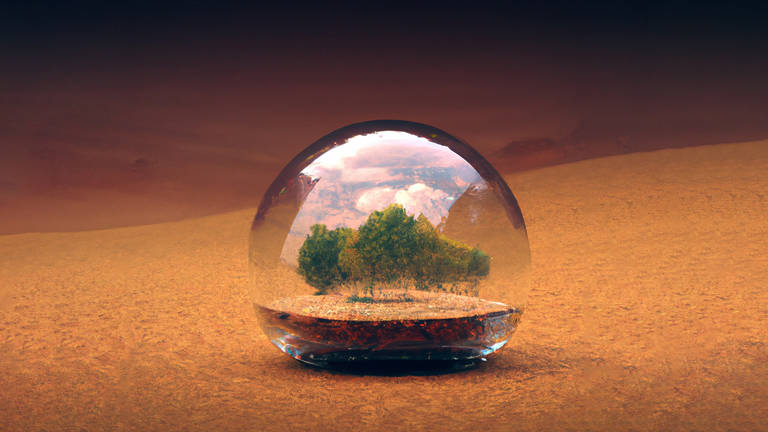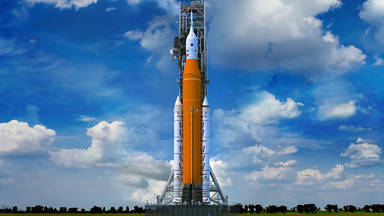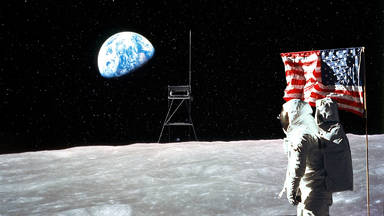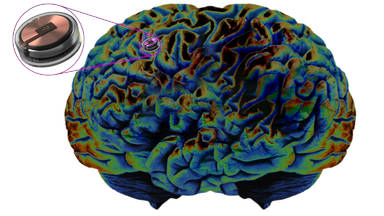
As humanity continues to search for ways to become a multi-planetary species, one scientist has proposed an ambitious and innovative solution: growing a forest inside a bubble on the surface of Mars.
The idea may sound like something out of a science fiction novel, but the technology needed to make it a reality already exists. In fact, the concept of building enclosed habitats on other planets has been around for decades, and many scientists believe that it will play a crucial role in allowing humans to live and work on the surface of Mars.
The proposed Mars forest would be grown inside a transparent, spherical structure made of a special material that is strong enough to withstand the harsh Martian environment. The structure would be pressurized to Earth-like levels, allowing plants to grow and thrive inside it. The forest itself would be a mix of trees and other vegetation, carefully chosen to support a sustainable ecosystem.
The trees would provide oxygen, while other plants would help to recycle waste and provide food for any animals that might be introduced into the ecosystem. The idea of creating an Earth-like environment on Mars has many potential benefits. For one, it would provide a safe and comfortable habitat for astronauts, who could live and work inside the forest bubble during their time on the planet.
The presence of vegetation would also help to regulate the temperature inside the habitat, making it more comfortable for humans to live in. In addition, the forest could serve as a valuable resource for future Mars settlers. The trees could provide building materials, and the plants could be used for food and other necessities.
Having a self-sustaining ecosystem on Mars would also be a significant step towards terraforming the planet, making it more hospitable for future generations of Martian settlers. Of course, there are many challenges to overcome before a Mars forest bubble becomes a reality.
The biggest challenge would be finding a way to provide the forest with the water and nutrients it needs to survive. On Earth, plants get these essential resources from the soil, but on Mars, the soil is not suitable for growing plants. One solution would be to use hydroponics, a method of growing plants in water without soil. This would allow the plants in the Mars forest to get the nutrients they need without relying on the Martian soil. Another option would be to use artificial soil, created using a mixture of Martian regolith (the loose rock and dust on the surface of the planet) and other materials.
Another challenge would be protecting the forest from the harsh Martian environment. The planet's surface is exposed to extreme temperatures, radiation, and other environmental hazards that could harm the plants and animals inside the forest bubble.
To protect the forest, the transparent structure would need to be coated with a special material that blocks UV radiation and other harmful elements. Despite these challenges, many scientists believe that the benefits of creating a Mars forest bubble outweigh the risks. In addition to providing a safe and comfortable habitat for astronauts, the forest could serve as a valuable resource for future Mars settlers and a stepping stone towards terraforming the planet.
If successful, the Mars forest bubble could be the first step towards building a thriving, Earth-like ecosystem on the surface of the Red Planet. It would be a testament to humanity's ability to adapt and survive in even the most hostile environments, and a reminder of our deep connection to the natural world.
One potential challenge is the cost of building and maintaining the forest bubble. The materials and technology needed to create a transparent, pressurized structure on the surface of Mars would be expensive, and it would require a significant investment of time and resources to make it a reality.
Another challenge is the uncertainty of whether plants and animals would be able to survive in the Martian environment. While it is possible that some species could thrive in the Mars forest bubble, others might not be able to adapt to the harsh conditions on the planet's surface. This would require careful planning and experimentation to determine which species are best suited for life on Mars.
To overcome these challenges, scientists would need to conduct extensive research and testing on Earth before attempting to build the Mars forest bubble. This would involve studying the Martian environment and experimenting with different materials and technologies to determine what would work best on the planet's surface.
One potential solution for the cost challenge is to use robotic technology to build and maintain the forest bubble. This would reduce the need for human workers on the surface of Mars, lowering the cost of the project. It would also allow for more precise and efficient construction, as robots would be able to work in the harsh Martian environment without the need for protective suits or other equipment.
To address the uncertainty of whether plants and animals could survive on Mars, scientists could use genetic engineering and other advanced technologies to create species that are specifically adapted to the Martian environment. This could involve modifying the genes of existing species to make them more resilient to the conditions on Mars, or creating entirely new species from scratch.
In addition to discussing these challenges and potential solutions, we could also delve deeper into the potential benefits of the Mars forest bubble. For example, we could describe how the presence of a self-sustaining ecosystem on Mars could be a significant step towards terraforming the planet, making it more hospitable for future generations of Martian settlers. We could also discuss how the forest could serve as a valuable resource for future Mars settlers. The trees in the forest could provide building materials, and the plants could be used for food and other necessities.
The presence of a diverse ecosystem on Mars would also support scientific research and exploration, as scientists could study the plants and animals in the forest to learn more about the Martian environment and the potential for life on the planet.
Overall, the idea of creating a Mars forest bubble is an ambitious and innovative solution to the challenges of establishing a human presence on the Red Planet. While there are many challenges to overcome, the potential benefits of such a project make it well worth pursuing. If successful, the Mars forest bubble could be a key step towards building a thriving, Earth-like ecosystem on the surface of Mars, and a testament to humanity's ability to adapt and survive in even the most hostile environments.









